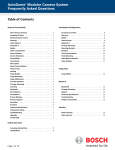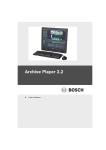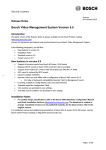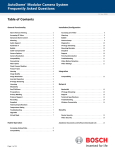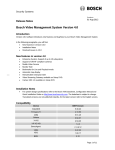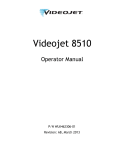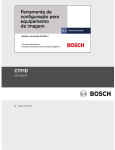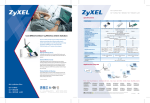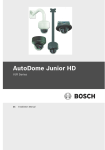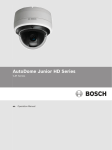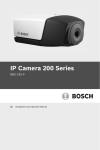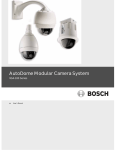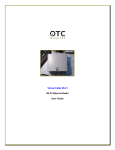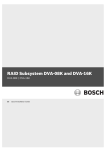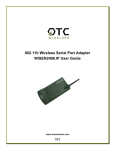Download Dinion IP FAQ.indd - Chesapeake / Midlantic Marketing
Transcript
Dinion IP Cameras Frequently Asked Questions General Functionality Q. Is special software required to view the IP video? A. You can view video and control all camera settings using Microsoft Internet Explorer. Additionally, you may use VIDOS Video Management software or DiBos 8.0 DVR to view and record the Dinion IP cameras. Q. How many users (simultaneous connections) are available for the IP video stream? A. All Dinion IP cameras support multi-unicast, multicast and streaming modes. The answer depends on the encoder’s settings and the capabilities of the network; 5 simultaneous users when in multi-unicast mode, up to 25 simultaneous users when in multicast mode. Q. Is there a PTZ version of the IP video camera available with control over the network? A. No, the Dinion IP and DinionXF IP are fixed cameras. If PTZ functionality is required use a VIP-X1 or VideoJet encoder and a Bosch AutoDome camera. Q. What determines the IP video format of NTSC or PAL? A. This is determined by the camera’s CCD imager. In NTSC cameras the imager runs at 30 IPS, and in PAL models at 25 IPS. This ensures that the image frequency matches the power frequency (60Hz for NTSC, 50Hz for PAL) so that the Dinion IP delivers the best possible image. It also ensures compatibility with existing analog video equipment. Q. Are the Dinion IP cameras available in the Unitypack product line? A. Not at this time. Q. Can I view video recorded using the Dinion IP with standard PC video players (e.g. Windows Media Player, QuickTime, etc.)? A. This answer depends on the selected video management system. DiBos (version 8), for example, allows you to export video so that it can be viewed in Windows Media Player. VIDOS exports in a proprietary format that can be played back in a freely distributed video player. Q. What makes Dinion IP cameras different from all of the others? Everyone talks about CIF, 4CIF, and D1 but I think many 4CIF recordings are not as good as CIF ones. A. Image size and frame rates alone are not a true measure of camera image quality. Dinion IP cameras combine award-winning imaging technology with state of the art compression and network capabilities. This results in a truly advanced network camera capable of revealing details standard cameras miss. Q. Does the picture look as good as a conventional Dinion or DinionXF? A. Absolutely, using 4CIF resolution at 25/30 IPS it is almost impossible to tell if the picture displayed on the monitor is traditional composite analog video or the compressed IP video stream. Q. What does 15-bit image processing do? A. 15-bit imaging technology enhances the accuracy with which the CCD signal is digitized and processed. Bosch’s 15-bit imaging delivers 32x better accuracy (compared to 10-bit cameras) which allows the DinionXF IP to reveal details other cameras cannot discriminate. Q. Does 15-bit XF-Dynamic increase the camera’s bandwidth requirements? A. No, the 15-bit processing just reveals more details which are hidden in 10-bit cameras and does not increase the bandwidth requirements. Q. What is the relationship between CIF resolution and TV lines? A. There is no relationship. CIF denotes the amount of pixels in the compressed image. Television Lines (TVL) denotes the capability of the imager to resolve small details. The actual details shown in the image depend on the compression and bandwidth settings. However, by having 540 TVL imager resolutions the Dinion IP cameras are capable of providing unmatched sharpness in the image, all tunable via the camera’s settings page. Q. MPEG-2 gives the best picture quality, can I use this with the Dinion IP cameras? A. MPEG-4 delivers images that are equally as good as MPEG-2 at 4CIF resolution and uses between 15-30% less bandwidth than MPEG-2. Page 1 of 5 Dinion IP Cameras Frequently Asked Questions Q. Can the Dinion IP stream JPEG and MPEG-4 to different devices? A. Yes, Bosch’s innovative tri-streaming feature enables Dinion IP to generate two independent MPEG-4 streams and a JPEG stream simultaneously. Each of these streams can be sent to separate devices. For example one stream could send low bandwidth CIF images to a remote central monitoring station, one stream could send 4CIF images to a local VIDOS NVR or DiBos DVR for recording, and a third stream could send JPEG images to a PDA device. Q. Does the Dinion IP provide digital zoom capabilities? A. No. However, the value of digital zoom is very limited as the quality of the image quickly deteriorates when you exceed a camera’s optical limits. Digital zoom simply magnifies part of the image. While increasing the size of objects in the picture, this magnification does not increase the details visible; it merely makes them and any visual artifacts larger. This is different to optical zoom which uses the full resolution available on a smaller field of view. Q. How do I decide whether to use MPEG-4 or JPEG? A. MPEG standards were developed for moving pictures and are designed to optimize streaming video performance. JPEG was developed for still images. When using JPEG in streaming video applications each individual frame or image must be encoded. MPEG differs from JPEG in that it uses interframe encoding which further compresses the video data by only encoding the differences (e.g. the pixels that have changed) between periodic key frames. MPEG-4 is the compression method of choice for all normal video viewing and recording over network as it is optimized for video, leading to lower bandwidth requirements. JPEG is generally only chosen for special tasks such as sending snapshots to FTP server Q. Can the Dinion IP support a motorized zoom lens? A. The Dinion IP and DinionXF IP do not support this. If this is required use the VIP-X1 encoder and a conventional analog camera. Q. Why does the IP Dinion have both MPEG-4 and JPEG streaming? A. MPEG-4 provides better quality video and uses less bandwidth. JPEG can be viewed with standard decoders available in the operating systems (e.g. on a PDA or with third-party video management systems). Q. If special software is required to view video via web browser, does this software require a license? A. An ActiveX component is required. This ActiveX component does not require a license and is automatically downloaded from the Dinion IP camera when connecting from Internet Explorer. Q. Can you support a pan and tilt device using the camera’s PoE capabilities? A. No, the current IEEE 802.3af standard limits Power over Ethernet output to 15 watts. Q. Does the Dinion IP support Power over Ethernet (PoE)? And what are the capabilities? A. Yes, the Dinion is IEEE802.3af compliant. All features of the camera are supported, including the simultaneous streaming of video to the network and the analog video output. Q. I want to use the IP Dinion camera in an outdoor housing; can I power the heater/blower using Power over Ethernet (PoE)? A. Unfortunately not, the current IEEE 802.3af standard limits Power over Ethernet output to 15 watts which is insufficient to power both the camera and a heater. Q. Does the camera provide the ability to capture a single image (i.e. snapshot)? A. Yes, directly from the live view page. Q. Is the Dinion IP camera the same size and shape as conventional Dinion cameras? A. Yes, the mechanical dimensions are identical to the equivalent Dinion Camera. Q. Other than IP video, do these units have the same features as the respective Dinion models? A. Yes all imaging features are present, but since these are network cameras they do not support Bilinx or the coax cable compensation features of the standard Dinion cameras. Q. Is the power connection the same as what is now offered in the Dinion? A. The external power supply input has exactly the same input voltage range as the analog camera models. Q. How much current does the Dinion IP camera draw? A. The maximum current is below 700 mA over the full input voltage range. Page 2 of 5 Dinion IP Cameras Frequently Asked Questions Q. What type of MPEG-4 compression is used (e.g. H.263, MPEG-4 Part 2, proprietary, etc.)? A. MPEG-4 Part 2. Q. When I open Internet Explorer to view video from the Dinion IP camera it asks for an MPEG ActiveX component. Where do I get it? A. The ActiveX component is supplied with the camera on the CD. If you have lost the CD or need the latest version, go to the Bosch website where it can be downloaded for free. http://www.boschsecurity.us/software.cfm?expandpr dctgroup=359&expandfamily=100&expandprdct=3429 Q. I have recorded an .mp4 archive onto my hard disk. How can I play this back? A. The MPEG player can be downloaded for free from the Bosch Security Systems website http://www.boschsecurity.us/software.cfm?expandpr dctgroup=359&expandfamily=100 Hybrid Operation Q. What receivers are required to view the IP video on an analog monitor? A. VIP-XD if full 4CIF real time images are required. VIPXD can also display quad image from 4 cameras. Q. Why is there still a coax connector connection on the back of the Dinion IP cameras? A. This connection can be used in hybrid systems, but also provides an easy way to set up the network addresses for the camera and to focus the camera using the lens wizard. Q. Can it be used point to point to an analog monitor, or VGA monitor? A. Yes, use a VIP XD Decoder. Q. Can I view analog pictures simultaneously with live viewing over the network? A. Yes. Q. Is the Dinion IP camera compatible with Bilinx control over the coax? A. No it is not compatible, but the full Bilinx functionality is available over the IP network via the built-in html setting pages. Installation/Configuration Q. Can you create customized web pages for viewing live video? A. No, this will be offered in the future via a web tool kit. Q. Is the camera capable of making an IP video connection triggered by alarm or motion? A. Yes. Q. Does the DinionXF IP transmit the alarm input data with the video? A. Yes, Dinion IP and DinionXF IP cameras support this functionality. Q. Can I switch the output relay remotely over network? A. Yes. Q. How can I transmit audio with the video? A. The Dinion IP and DinionXF IP do not support audio. If this is required use the VIP-X1 encoder and a conventional Dinion camera. Q. What camera settings are available over the browser interface? A. All camera settings are directly available via the HTML settings pages. Q. How will the programming of the camera be accomplished for IP addresses and network function? A. Via the On-screen Display (OSD) on an analog monitor or via the HTML settings pages. Q. How will the programming of the camera be accomplished for camera feature set (similar to Bilinx)? A. Via the HTML settings pages only. Q. What is the factory default IP address? A. 192.168.0.1, the same as all Bosch Video over IP (BVIP) devices. Q. Can you set a limit for the number of allowable simultaneous connections? A. No, the number of connection is depending on the transmission mode you choose. Q. What is the length of cable allowed for PoE? A. PoE wiring distances are limited to 100m (328 ft.). Q. How can I transmit serial data with the video? A. The Dinion IP and DinionXF IP do not transmit serial data. If this is required use the VIP-X1 encoder and conventional analog camera. Page 3 of 5 Dinion IP Cameras Frequently Asked Questions Q. Can the camera send a snapshot image (smtp, http, ftp, PDA, etc.) on an alarm (video motion detection, dry contact, etc.)? A. Yes, this can be accomplished via an http request. For example: http://IP-address/snap.jpg. Q. Is there a tool/utility to push firmware updates to multiple Dinion IP cameras simultaneously? A. Yes, the VIDOS video management system can be used to simultaneously push firmware updates to multiple Dinion IP cameras. Q. Can you synchronize camera time/date with a specific PC or DVR? Network Time (NTP) Server? A. Yes, the Dinion IP supports the time protocol (RFC 868). Q. Are there tools to determine if the camera is getting enough power? A. No special tools are needed. If the camera produces a stable image, enough power is supplied. Q. I’m dropping frames and getting artifacts, what should I do? A. Take a look at the encoder settings. This might happen if you are attempting to send large images at high frame rates but have set the bandwidth and quality settings very low. It may it may be that the data rate required to deliver the desired settings is too high for the bandwidth that is available on the network. Try using a smaller image size or lower frame rate and see if performance improves. If not, this might also indicate a network congestion problem. Q. How many motion detection “zones” or “areas” can you create? A. The Dinion IP provides one motion detection zone, the DinionXF Day/Night IP provides four zones. Q. Are the video motion detection “zones” or “areas” individually configurable? A. The DinionXF Day/Night IP camera provides four motion detection zones, which can be individually positioned and each have individual motion threshold settings. Q. What CIF settings are available on the Dinion IP cameras? A. Each Dinion IP camera supports 4CIF (full imager resolution), 2CIF, 1/2 D1, CIF and QCIF. Q. Can individual video clients use different image settings (i.e. different image sizes, image quality settings, and frame rates)? A. No but each Dinion IP camera can deliver up to three independent IP video streams. The image settings (image size, quality, frame rate, etc.) for each IP stream can be configured independently. Integration Q. Does Bosch provide DVRs to record the IP video of these cameras? A. The DiBos version 8.0 is capable of displaying and recording IP video streams from up to (32) Dinion IP camera connections. In addition Dinion IP video can be recorded on VIDOS Network recorder. Q. Is the Dinion IP compatible with other manufacturers’ products? A. It is possible to integrate the JPEG video stream to virtually any third-party JPEG or MJPEG-compatible video management systems. Network Q. How much bandwidth is required on the network for each IP video? A. Dinion IP cameras can be configured for specific bandwidth targets and limits. You can scale the bandwidth from 10Kbps to 10Mbps. The amount of bandwidth required per camera depends on image size, frame rate, the quality settings (e.g. amount of compression) selected, and the activity levels within the scene. If we assume CIF resolution and medium activity levels bandwidth will average between 100500Kbps at 25/30 IPS If we assume 4CIF resolution and medium activity levels bandwidth will average between 400Kbps and 2Mbps at 25/30 IPS. Q. Does the bandwidth requirement on the network increase with multiple connections? A. Each multi-unicast stream needs its own bandwidth, for example three recipients looking at a 1 Mbps video stream will consume 3 Mbps of network bandwidth. In multicast mode, each additional stream consumes near-zero additional bandwidth, so the three recipients will be demanding only 1 Mbps from the encoder. Q. Can you configure bandwidth limits for the Dinion IP camera? A. Yes, via the camera settings page. Page 4 of 5 Dinion IP Cameras Frequently Asked Questions Q. How can I set the IP address of the camera, if I don’t have a conventional CCTV monitor available? A. Via the settings pages. You first have to connect to the camera via the default address and then change the IP address. Q. A few people want to view the same camera. How do I configure multicast on our switch? A. Configuring a managed switch to support multicast requires some understanding of how the switch works. Please refer to the switch’s user manual. Q. What type of switch do I need to power these? A. Any IEEE 802.3af-compliant network switch can be used with Dinion IP cameras. Power over Ethernet capabilities can be added to existing non-PoE switches by using a mid-span hub which feeds power onto one of the unused wire pairs in the Cat5e/ Cat6 UTP cable. The cameras can also be powered conventionally via any 12VDC or 24VAC power supply. Q. I do not have Java installed, where can I get this? A. The Sun Java components can be downloaded for free from http://java.sun.com/products/plugin/ downloads/index.html Q. Do Dinion IP camera support unicast streaming? A. Yes. Q. Do Dinion IP cameras support multicast streaming? A. Yes. Q. Do Dinion IP cameras support broadcast streaming? A. No. Q. Do Dinion IP cameras support SNMP so that it can be managed by my network management tools? A. No, Dinion IP and DinionXF IP cameras do not offer SNMP support at this time. Q. Are there any wiring distance limitations? A. The IEEE 802.3 standard limits Ethernet communications over Cat5e/Cat6 UTP copper to 100 m (328 ft.). If your application has cameras beyond the 100-meter reach of copper, a remote data closet would be needed. Alternatively, a UTP to fiber optic media converter can be used to extend wiring distances from 2 km (6560 ft.) to 5 km (16,400 ft.) or more. Q. Do Dinion IP cameras support DHCP? A. No. Q. Do Dinion IP cameras support DNS? A. No. Q. What should I do when I can’t see the camera but I can ping it? A. Since you can ping the camera it is configured correctly for the network and has a unique IP address. The next step is to pull up a web browser and point it at the camera, confirm that the camera delivers a web page and then view the MJPEG video stream. If you can view the MJPEG stream but not the MPEG-4 streams, verify that you have the latest Bosch MPEG-ActiveX driver installed. If the MPEG-ActiveX driver is installed and you still cannot see the video, you may need to adjust your firewall settings. Page 5 of 5 Q. I do not have the Bosch MPEG-ActiveX driver installed. Where can I get this? A. The latest DirectX version is available from the Bosch website http://www.boschsecurity.us/software.cfm?e xpandprdctgroup=359&expandfamily=100&expandprd ct=3426 Q. I do not have DirectX 9.0 installed. Where can I get it? A. The MPEG-ActiveX driver is included on the Dinion IP Installation CD. The driver is also available from the Bosch website http://www.boschsecurity.us/ software.cfm?expandprdctgroup=359&expandfamily= 100 Q. Can the Dinion IP camera transmit a wireless video signal? A. Dinion IP cameras can be connected to any 802.11compliant device point (multipoint) or access point (point-to-point) RF link for wireless video streaming from remote camera sites. Dinion IP can also be integrated with various licensed RF, microwave and laser-based wireless transmission technologies. Security Q. Can you restrict access to the Dinion IP (e.g. setup user accounts, IP address filtering, etc.)? A. Yes, there are three user levels, each with their own password and authorizations. Q. Can you configure the Dinion IP to use specific network ports (e.g. use an http port other than 80, etc.)? A. Yes, communication can be switched to TCP Port 80, all the data will then tunneled through TCP Port 80. Q. Is the camera’s video stream encrypted to prevent unauthorized viewing? A. No there is no encryption inside the Dinion IP, but it is possible to use third-party devices to encrypt the data stream coming out of the Dinion IP. It is also possible to setup different user levels with different access rights/privileges on the Dinion IP.





